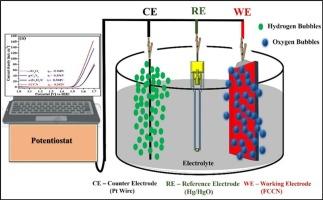提高电催化活性的MIL-Fe-88衍生α-Fe2O3/C@g-C3N4三元复合材料:OER稳定性预测和机器学习预测
IF 5.9
3区 工程技术
Q1 CHEMISTRY, MULTIDISCIPLINARY
Journal of Industrial and Engineering Chemistry
Pub Date : 2025-05-24
DOI:10.1016/j.jiec.2025.05.036
引用次数: 0
摘要
本研究开发了一种合成MOF衍生物的新方法;α-Fe2O3/C@g-C3N4 (FCCN)复合材料电导率提高,用于高效电催化析氧反应(OER)采用XRD、FT-IR、RAMAN、SEM、TEM、XPS等表征手段对FCCN及其同类材料的理化性质进行了分析。利用循环伏安法(CV)、线性扫描伏安法(LSV)和电化学阻抗谱(EIS)对FCCN复合材料的电化学析氧性能进行了评价,结果表明,与α-Fe2O3和g-C3N4相比,FCCN复合材料的电化学析氧性能有所提高。值得注意的是,FCCN在电流密度为10 mA cm−2时的过电位(η)为292 mV, Tafel斜率为57 mV dec−1,在12小时内具有显著的稳定性(98%),与其他样品相比,反映了较强的OER性能。通过时间序列分析,通过机器学习建模、预测和预测FCCN的OER稳定性表明其功能在未来1700秒内保持不变。α-Fe2O3/C与g-C3N4之间的协同作用使得FCCN复合材料具有较高的OER活性和高的稳定性,从而提高了表面活性位点的密度和导电性。本文章由计算机程序翻译,如有差异,请以英文原文为准。

MIL-Fe-88 derived α-Fe2O3/C@g-C3N4 ternary composite with boosted electrocatalytic activity: OER stability prediction and forecasting via machine learning
In this study, a new approach was developed for the synthesis of MOF derived; α-Fe2O3/C@g-C3N4 (FCCN) composite with boosted conductivity for efficient electrocatalytic oxygen evolution reaction (OER). The physico-chemical properties of FCCN composite and their counterparts were analyzed by using characterization such as XRD, FT-IR, RAMAN, SEM, TEM, and XPS analyses. The electrochemical oxygen evolution performance of the FCCN composite was evaluated using cyclic voltammetry (CV), linear sweep voltammetry (LSV), and electrochemical impedance spectroscopy (EIS), demonstrating enhanced activity as compared to bare α-Fe2O3 and g-C3N4. Notably, FCCN achieved a low overpotential (η) of 292 mV at a current density of 10 mA cm−2 and a Tafel slope of 57 mV dec−1, with remarkable stability over 12 h (98 %), reflecting strong OER performance in comparison with other samples. The OER stability of FCCN modelled, predicted and forecasted by machine learning through time series analysis indicated retention in its functionality over next 1700 s. The superior OER activity with high stability of FCCN composite is credited to the excellent synergy between α-Fe2O3/C and g-C3N4 resulting in high density of surface-active sites and enhanced electrical conductivity.
求助全文
通过发布文献求助,成功后即可免费获取论文全文。
去求助
来源期刊
CiteScore
10.40
自引率
6.60%
发文量
639
审稿时长
29 days
期刊介绍:
Journal of Industrial and Engineering Chemistry is published monthly in English by the Korean Society of Industrial and Engineering Chemistry. JIEC brings together multidisciplinary interests in one journal and is to disseminate information on all aspects of research and development in industrial and engineering chemistry. Contributions in the form of research articles, short communications, notes and reviews are considered for publication. The editors welcome original contributions that have not been and are not to be published elsewhere. Instruction to authors and a manuscript submissions form are printed at the end of each issue. Bulk reprints of individual articles can be ordered. This publication is partially supported by Korea Research Foundation and the Korean Federation of Science and Technology Societies.

 求助内容:
求助内容: 应助结果提醒方式:
应助结果提醒方式:


